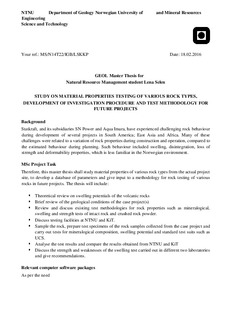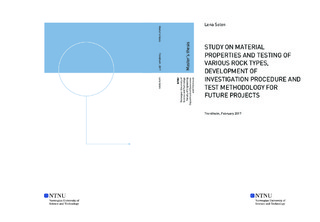| dc.description.abstract | This master thesis aims to provide insight and qualitative information about swelling
mechanisms in volcanic rocks, in particular the swelling of rocks related to hydropower
water tunnels. Additionally, traditional laboratory methods for determining the main
rock material properties controlling swelling behavior are investigated. The rock
samples tested are obtained from the Alimit area in Philippines, where The Alimit HEPP
is in its feasibility phase. The hope is to provide an enhanced understanding of the
swelling potential of the volcanic rocks, and introduce a suggestion on a proper
investigation procedure to detect potential challenges at an early stage.
The first step in this investigation, was to get an overview of the status quo in swelling
rock sciences. The further work was based on the leading hypothesis on swelling clay
minerals (i.e. smectites or similar groups of swelling clay minerals) to be the main cause
of tunnel collapses in previous projects. Other explanations, as the swelling of chlorites
and zeolites, and moisture swelling, were also kept in mind during the investigations.
The next step was to survey the project case site, located in the Ifugao province of the
Philippines, to get an overview of the geological and topographical features of the area.
Sampling of the assumed most dominating rock types, with focus on regions in which
major constructions are planned, was performed. The samples were obtained from the
borehole core storage of SN Aboitiz (cooperating partner of SN Power/Statkraft) in
Lagawe, Philippines.
The main part of the investigation procedure was to obtain information on rock material
key properties of the collected samples, by different laboratory test methods. The
samples underwent mineralogical analyses, UCS-tests, and different types of swelling
tests. Oedometer swelling tests were performed at two different institutes (NTNU and
KiT), for comparison of methodology and output.
The study has uncovered an unexpected swelling potential of strong, andesitic rock
types, despite the lack of swelling clay minerals in the samples tested. The swelling
pressure magnitudes are confirmed by repeated tests, and apply on the results obtained
at both institutes. The swelling potential is assumed closely linked to the high content
of laumontite (zeolite). Content of swelling clay minerals, in particular montmorillonite,
ii
is detected in other rock types tested. The rock material of these samples are weak and
disintegrated, and thus not up to standards for UCS testing. However, the swelling
pressure magnitudes are lower in the weak material, compared to the strong andesitic
rock.
The comparison of the oedometer methodology in operation at NTNU and KiT,
uncovered important differences between the two institutes. The deviations apply on
both the apparatus used, and the procedures of swelling tests. The differences include
the version of the ISRM suggested methods, intern modifications on apparatus and
procedures, and intern traditions in how specific points in the ISRM standard is
translated in practice.
Based on the work performed throughout the investigation, a suggestion on an improved
investigation procedure is presented at the end of this thesis. | |

